U.S. Dollar in Darkest Day Since May Capitulation as Yield Fears See GBP/USD Eye 2-Year Highs
- Written by: James Skinner
-
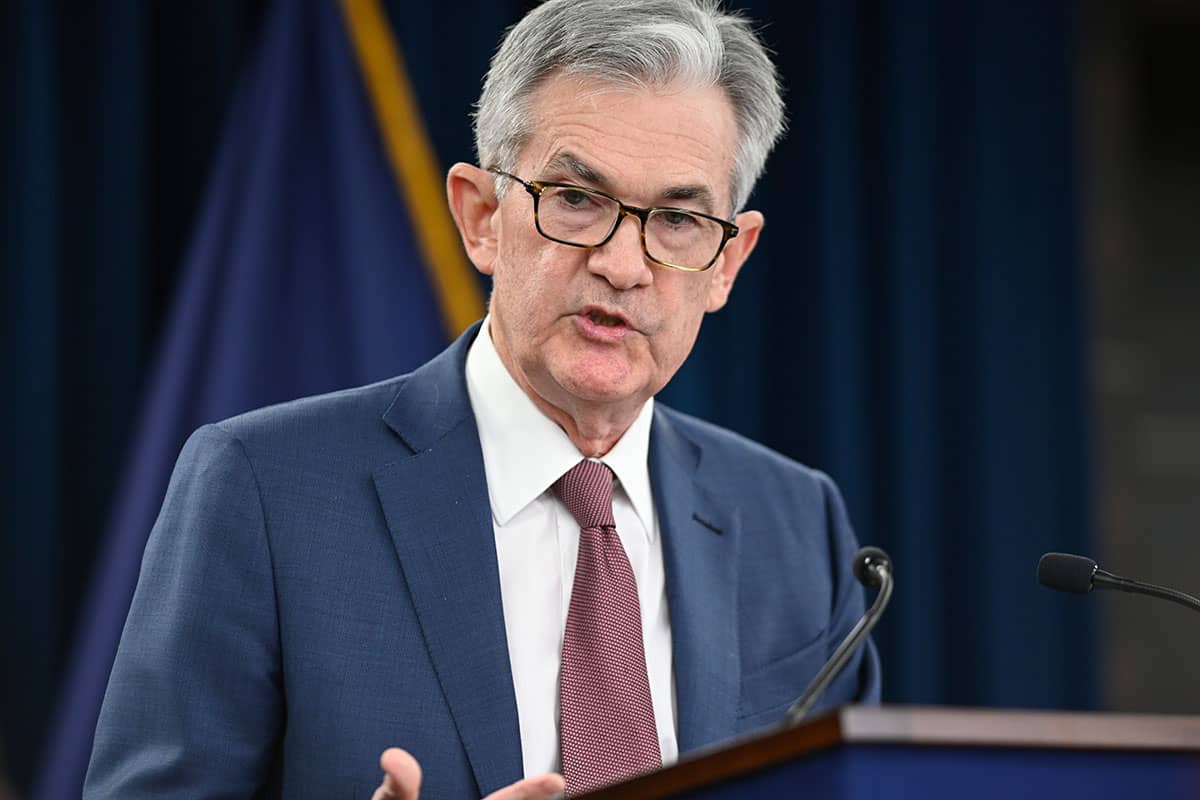
Above: Federal Reserve Chairman Jerome Powell. Image © Federal Reserve.
- GBP/USD spot rate at time of writing: 1.3327
- Bank transfer rate (indicative guide): 1.2971-1.3065
- FX specialist providers (indicative guide): 1.3138-1.3218
- More information on FX specialist rates here
The Dollar Index was on course for its steepest loss since its May capitulation as the U.S. yield outlook darkened following a strategy change at the Federal Reserve (Fed), which has lifted the Pound-to-Dollar rate to eight month highs while offering a glimpse of levels not seen since early 2018.
Dollars were sold en masse after the Federal Reserve (Fed) said on Thursday it will deliberately foster above-target inflation and that interest rates will still remain pinned to the floor as price pressures rise.
The policy implies further falls in 'real' bond yields that represent the inflation-adjusted returns earned by investors.
Previously above-target inflation could've been likely to incite an interest rate rise but now the Fed says it will use its monetary policy to actively foster above-target inflation in order to make nice for past as well as present periods where it has fallen short of the objective for 2% price growth.
"Recall that high nominal and real dollar rates were the key ingredients behind USD strength in prior years," says Petr Krpata, chief EMEA strategist for currencies and bonds at ING. "The adoption of average inflation targeting and tolerance for an inflation overshot (to make up for prior undershoots) suggests (a) interest rate increases are a very distant proposition; and (b) USD real rate will remain low and may even go (initially) lower if the Fed succeeds in generating higher domestic price pressures."
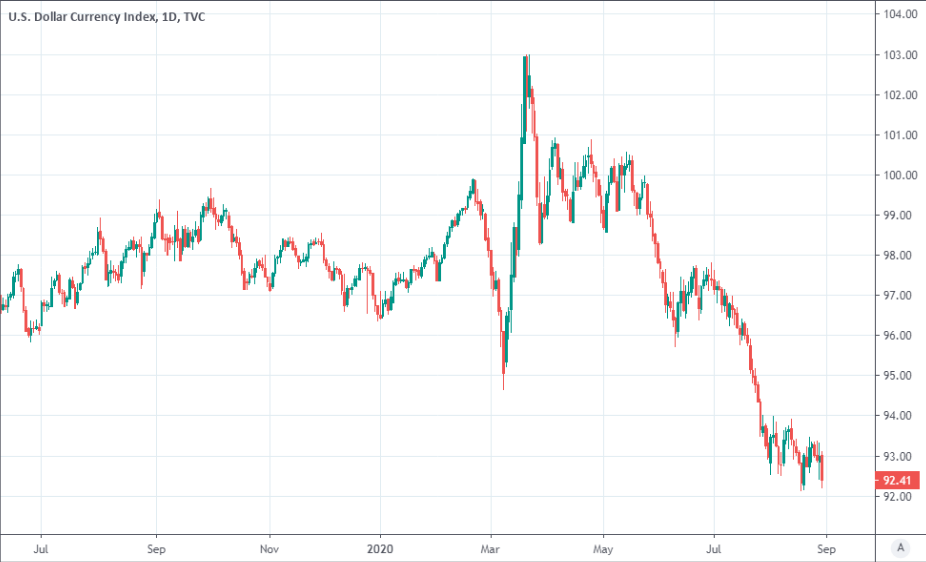
Above: U.S. Dollar Index shown at daily intervals.
The Dollar Index was down -0.92% at 92.19 at its lowest ebb Friday, which was its steepest intraday loss since May 26 when the barometer of the U.S. currency came into contact with an important technical support level that later failed, enabling a -7% decline between May and last Monday.
Dollar losses lifted Sterling above two notable technical resistance levels in early morning trade, leading it up to 1.3358 in the noon session and its highest level since December 2019. GBP/USD accounts for 11.9% of the Dollar Index.
"Above here there is a vacuum of meaningful resistances, suggesting a range breakout could lead to a quick move up to 1.3514, the high of 2019, with minor levels on the way seen at 1.3338, then 1.3422," says David Sneddon, head of technical analysis research at Credit Suisse.
There's now little standing in the way of a further rally by Sterling, technical analysts say, and if the British currency is able to get past its 1.3519 December peak then it would be found trading at its highest since early 2018. 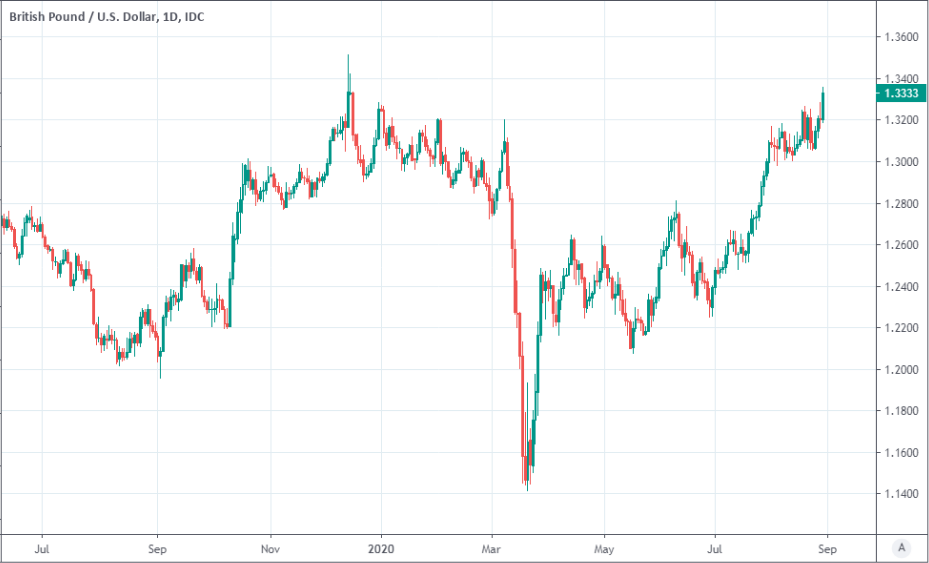
Above: Pound-to-Dollar rate shown at daily intervals.
The Pound rallied to 1.3519 following the election of Boris Johnson's Conservative Party in December but was only able to sustain such lofty heights for a fleeting moment before fears of a Bank of England rate cut, familiar uncertainties about Brexit and the coronavirus pandemic saw it unravel.
"Euro/dollar excitedly punched above the 1.1840s resistance level yesterday as Jerome Powell announced average-inflation-targeting and, while it swiftly reversed lower on “actual” policy-action disappointment into the NY options cut, the buyers staunchly defended familiar chart support in the 1.1760s," says Eric Bregar, head of FX strategy at Exchange Bank of Canada. "Chinese yuan and Japanese yen strength very much led EURUSD higher through the 1.1840s in overnight trade and so we don’t want to read too much into the street’s new found consensus view that the Fed will pull another rabbit (or dove) out of its hat in September. Month-end USD sales are also widely being reported and we’d give credence to this dynamic as well."
Europe's single currency, which accounts for 57% of the Dollar Index, saw its strongest gain since July when rallying to 1.1918, but didn't reach new highs.
The Euro has been consolidating beneath the 1.1965 peak set on August 18 over the last week although analysts envisage further gains before year-end.
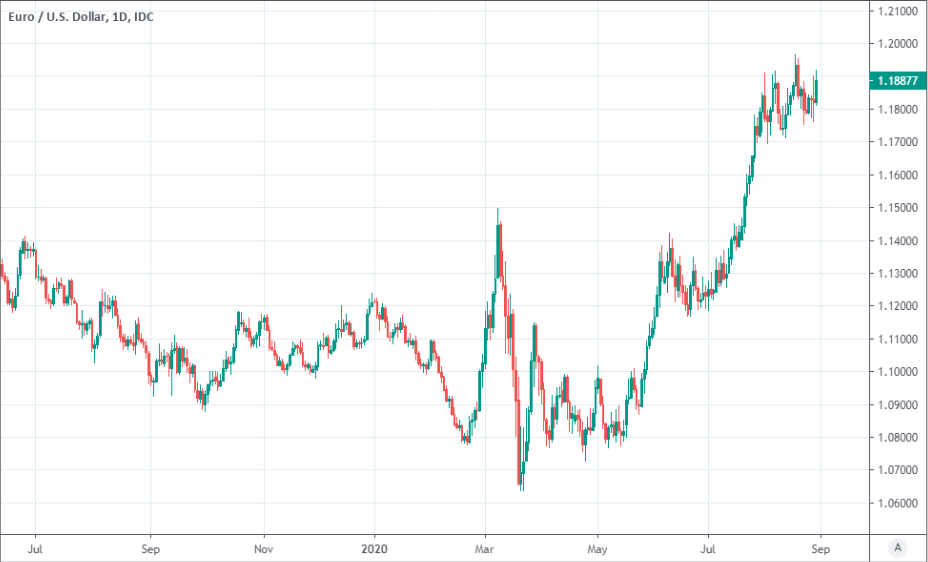
Above: Euro-to-Dollar rate shown at daily intervals.
The Dollar's steepest losses in the major currency space came against the Japanese Yen, which accounts for 13.6% of the Dollar Index, outperformed all rivals after earlier reports suggesting that Prime Minister Shinzo Abe was on the verge of resigning from office for health reasons were confirmed as accurate.
Abe told a press conference Friday that he will continue in his role until an as yet unknown successor is found, leading markets to speculate that an end of Abenomics could be near. The outgoing PM's 'three arrows' strategy of combining fiscal and monetary policies and structural economic reforms, aimed at reviving the fortunes of a long stagnating Japanese economy, was responsible for the lifting USD/JPY from 86 in January 2013 to 105 by year-end. However, some analysts are sceptical that a change of leadership will lead to a change of policy for a range of reasons and not least of all the economic turmoil kicked up by efforst to contain the coronavirus.
"The outline of a new monetary policy strategy by Fed Chair Powell at Jackson Hole has helped fuel expectations of some additional monetary easing to back up the change in strategy. Judging from the steepening of the yield curve in the US this week that policy shift will equate to action to reinforce ‘lower for longer’ even if/when inflation starts to pick up. That belief is set to keep short-end yields anchored and potentially drive real yields lower still," says Derek Halpenny, head of research, global markets EMEA and international securities at MUFG. "Questions over Abenomics in conjunction with the broader USD move leaves USD/JPY vulnerable to the downside over the short-term. However, it is the broader USD bearish view that will be most important in USD/JPY falling from here, not a shift in policy in Japan which we do not expect to be significant given the degree of progress made under Abenomics."
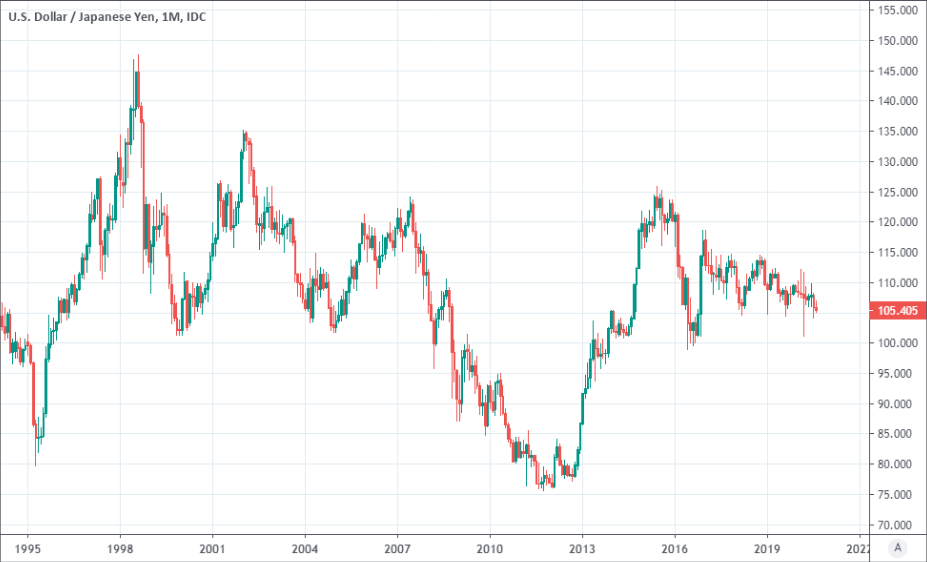
Above: USD/JPY rate shown at monthly intervals.










